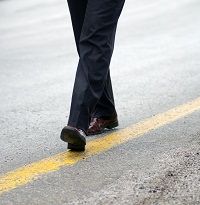Article
Vibrating Soles May Prevent Falls to Patients with Multiple Sclerosis
Author(s):
A new test will aim to determine if vibrating soles can prevent falls in patients with multiple sclerosis, by training them to strengthen muscles and balance.

Vibrating soles may assist people with multiple sclerosis (MS) who have trouble with balance and a fear of falling, according to a pilot study to be conducted over the next year at the University of Massachusetts Amherst.
Funded by the National Multiple Sclerosis Society, the $39,000 1-year grant will allow researchers to determine how sensation in the feet while standing relates to balance ability and if vibrating soles may aid walking and balance. These issues present negative effects on multiple sclerosis patients’ quality of life by holding them back from social gatherings, regular exercise, and community activities. However, a university press release noted, fatigue and anxiety about walking can be taxing for the patients.
The test will be the first of its kind, especially because traditionally these types of tests are performed with the participants lying down. This test will examine sensation in 2 specific areas of the soles of the feet while participants are standing and sitting. The data collected will be used to elucidate how soles relate to balance activity.
The pilot test will involve 30 subjects — both with and without multiple sclerosis – recruited between the ages of 21 and 65 years who are ambulatory and able to stand unassisted. Some of the baseline tests will include a 25 foot walk, muscle strength testing, tests of pressure and vibration sensation of the skin, standing balance, and posture evaluation.
“There is a lot of evidence that the somatosensory system, that is the skin’s sensation and body awareness or proprioception, is affected in people with MS, who often report peripheral sensory loss, for example,” said research assistant professor in the kinesiology department Stephanie Jones, PhD.
The researchers will build on previously developed technologies that improved skin sensation using vibrating soles to the feet below the threshold of detection. These vibrations were successful in restoring some of the lost sensation and improving balance in people with sensory loss in their feet due to diabetes or stroke.
“This method exploits the phenomenon of stochastic resonance of the nervous system,” Jones continued in the press release. “It applies a kind of ‘noise’ that can enhance a person’s skin sensation.”
The investigators will use devices called “tactors” which are placed inside participants’ shoes to produce vibrations. The investigators will determine the most sensitive part of participants’ soles, after which they will take a test without knowing if the sensations are on or off. They will complete 5 different postural conditions and then repeat them after a 5 minute wait to see if there is a continued effect from the vibrations.
In the final phase of the study, the tactors will be tested in people with multiple sclerosis to see if they can detect and respond to balance changes. Those participants will stand on a platform that is designed to suddenly move about 3 inches, which is not enough to cause most people to fall. However, it will cause the activation of muscles that are needed to remain upright. The hope is that the tactors assist these muscles in firing sooner, to reduce the overall frequency of falls.
“Because their nervous system is compromised, people with multiple sclerosis show a much greater delay in detecting and responding to unexpected balance disturbances,” Jones concluded. “One of our goals is to see if we can enhance the ability to detect and respond to a sudden challenge and in doing so, improve balance. In this case, the challenge will be a shift of the surface underfoot, a bit like what you get when you step onto an escalator. If we identify this mechanism of somatosensory impairment in multiple sclerosis, perhaps we can develop other interventions to try to do more.”




